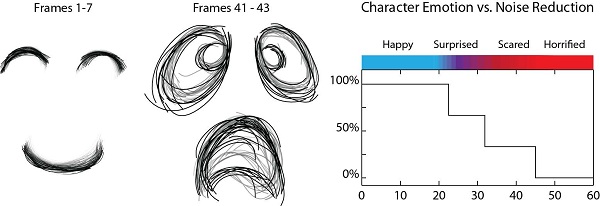Temporal Noise Control for Sketchy Animation
G. Noris, D. Sykora, S. Coros, B. Whited, M. Simmons, A. Hornung, M. Gross, R. SumnerProceedings of the 9th International Symposium on Non-Photorealistic Animation and Rendering (NPAR) (Vancouver, Canada, August 5-7, 2011), pp. 93-98
Overview
The richness provided by the sketchy style can be considered to be a form of geometric noise. Despite its positive benefits in still images, geometric noise becomes temporal noise in sequences of sketches and is generally unpleasant to view. The method we introduce offers artistic control over the level of temporal noise in hand-drawn animations. Mismatches in the individual strokes used to define the same silhouette in consecutive frames can be a major source of temporal noise, particularly in rough sketches. Our goal is to preserve the expressiveness inherent in sketchy drawings while removing unpleasant temporal issues.We propose to reduce temporal noise while keeping geometric noise by supporting interpolation at a finer level, down to the individual sketchy strokes. Instead of appearing and disappearing, the strokes transition smoothly from frame to frame. Enforcing these constraints manually in typical production environments would be impractical: establishing a fine-scale correspondence of strokes within the sequence of sketches and generating the proper animation path is too labor-intensive.
Results
Our algorithm succesfully reduces the amount of temporal noise present in an animation by enforcing temporal coherence through stroke inbetweening. The results are best shown in the video on top. In a first phase, our algorithm generates a so called "noise-free" sequence (see Figure 2), by sampling the input animation, and animating the individual strokes that compose them.
In a second phase, called "Continuous Noise Reduction" (see Figure 1), we achieve the desired level of noise reduction by interpolating the input and noise-free animations. Generally speaking, we seek to maintain the global motion of an input animation, as well as the overall drawing style, while manipulating the temporal noise level. Smooth output animations are typically preferred, but we note that high-frequency noise can be an effective artistic tool. The animation of a character who is scared, for instance, could benefit from a certain amount of temporal noise to emphasize emotion (see Figure 3).





